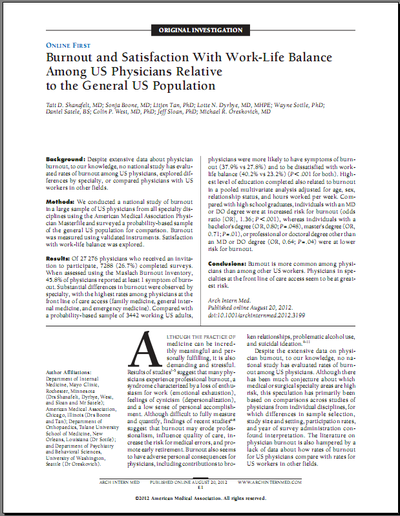Burnout and Satisfaction With Work-Life Balance Among US Physicians Relative to the General US Population.
Les conclusions d’un récent sondage mené auprès de médecins américains abondent dans le même sens que celles tirées d’études réalisées au Canada antérieurement, à savoir que l’épuisement professionnel chez les médecins est un problème grave.
Les résultats d’une enquête menée auprès de 7 288 médecins et publiés en août par les Archives of Internal Medicine [Voir ci-dessous] montrent que 45,8 % des répondants ont dit avoir au moins un symptôme d’épuisement professionnel.
L’étude américaine arrive 9 ans après un sondage effectué par l’AMC auprès de 8 172 médecins canadiens, qui avait alors révélé que 45,7 % des répondants en étaient à des « stades avancés d’épuisement professionnel ». Ces résultats avaient été publiés en 2003, année où l’AMC a inauguré son Centre pour la santé et le mieux-être des médecins.
Lire La suite Épuisement professionnel des médecins : « niveau alarmant » chez nos voisins du Sud, AMC, Patrick Sullivan, 04 septembre 2012
La référence
Auteur Tait D Shanafelt
Auteur Sonja Boone
Auteur Litjen Tan
Auteur Lotte N Dyrbye
Auteur Wayne Sotile
Auteur Daniel Satele
Auteur Colin P West
Auteur Jeff Sloan
Auteur Michael R Oreskovich
Résumé BACKGROUND Despite extensive data about physician burnout, to our knowledge, no national study has evaluated rates of burnout among US physicians, explored differences by specialty, or compared physicians with US workers in other fields. METHODS We conducted a national study of burnout in a large sample of US physicians from all specialty disciplines using the American Medical Association Physician Masterfile and surveyed a probability-based sample of the general US population for comparison. Burnout was measured using validated instruments. Satisfaction with work-life balance was explored. RESULTS Of 27 276 physicians who received an invitation to participate, 7288 (26.7%) completed surveys. When assessed using the Maslach Burnout Inventory, 45.8% of physicians reported at least 1 symptom of burnout. Substantial differences in burnout were observed by specialty, with the highest rates among physicians at the front line of care access (family medicine, general internal medicine, and emergency medicine). Compared with a probability-based sample of 3442 working US adults, physicians were more likely to have symptoms of burnout (37.9% vs 27.8%) and to be dissatisfied with work-life balance (40.2% vs 23.2%) (P < .001 for both). Highest level of education completed also related to burnout in a pooled multivariate analysis adjusted for age, sex, relationship status, and hours worked per week. Compared with high school graduates, individuals with an MD or DO degree were at increased risk for burnout (odds ratio [OR], 1.36; P < .001), whereas individuals with a bachelor’s degree (OR, 0.80; P = .048), master’s degree (OR, 0.71; P = .01), or professional or doctoral degree other than an MD or DO degree (OR, 0.64; P = .04) were at lower risk for burnout. CONCLUSIONS Burnout is more common among physicians than among other US workers. Physicians in specialties at the front line of care access seem to be at greatest risk.
Publication Archives of internal medicine
Pages 1-9
Date Aug 20, 2012
Chercher cette référence sur : Google Scholar, Worldcat
doi:10.1001/archinternmed.2012.3199
Laisser une réponse
Vous devez etre connectez Pour poster un commentaire









